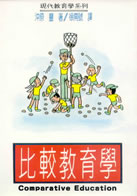| Okihara, Yutaka, (1995). Bi jiao jiao yu xue. First edition First print (1989). Second Print (1995). Translated by Xu Nan Hao. Taipei: Shui Niu tu shu chu ban shi ye you xian gong si | |
|
|
An overview of the book (383 English words): This is an introductory classic book on comparative education, concerning its concepts, aims, value judgement, methodology and historical development under Capitalism and Socialism,. Meantime, it identifies several famous comparative research centres and their functions, some representative comparativists and investigates the dynamics of comparative education, when interacting with international education and simultaneously activated by national, multi-national and international organizations or educational societies. The main content is written, based on a lengthy list of relevant Western and Eastern (mainly Chinese and Japanese) literature on comparative education. Chapter one introduces the essences, aims, laws and value judgements of conducting comparative educational research, especially about the inter-national transferability of educational lessons. Chapter two traces out the historical development of comparative education from ancient Rome, Greece to modern France, United Kingdom and United States of America, coupled with some external social factor analysis and some social science theory applications. Chapter three analyzes some renowned comparativists, their methodological frameworks and socio-historical development of comparative education in former USSR and East Germany, under the socio-ideological doctrines of Leninism and Marxism. In chapter four, distinctive socio-historical development of comparative education is traced out from ancient Tong Dynasty to modern Japan, with some further depiction of its ongoing interactions in Japan with other developed and developing nations. Chapter five briefs out some eminent works of some giants in comparative education, including Marc A. Jullien, Michale, E. Sadler, Issac L. Kandel, Friedrich Schneider, Nicholas Hans, A. H. Moehlman, W.W. Brickman, George Z. F. Bereday, C.A. Anderson, Harold J. Noah & Max A. Eckstein, Brian Holmes and Edmond King. Chapter six summarizes some basic steps in doing comparative education, including hypothesis-testing, ‘description-interpretation-juxtaposition-comparison? conceptual elucidation and indicators, data-source triangulation and data-handling techniques. Chapter seven mentions comparative education research centres in nation, global and international scales. Chapter eight reports research literature on comparative education, including periodicals, journals, encyclopedia, reference books and comparative education society newsletters. Chapter nine sketches the dynamics of comparative education, touching its recent research agendas and methodological shifts internationally, continentally in Europe and North America and nationally in Japan. Multi-faceted relationships of comparative education with international education, educational planning, teacher education, learning subjects and schooling reforms are articulated in detail respectively from chapter ten to chapter fourteen. Chapter fifteen discusses methodological topics and anticipates future trends of school reforms in international and global perspectives. |
-
Recent News
Archives




